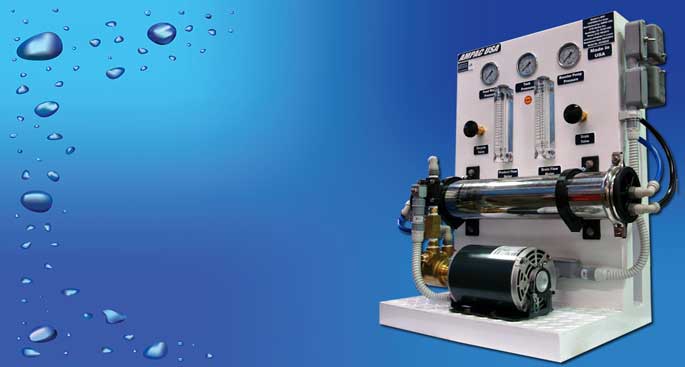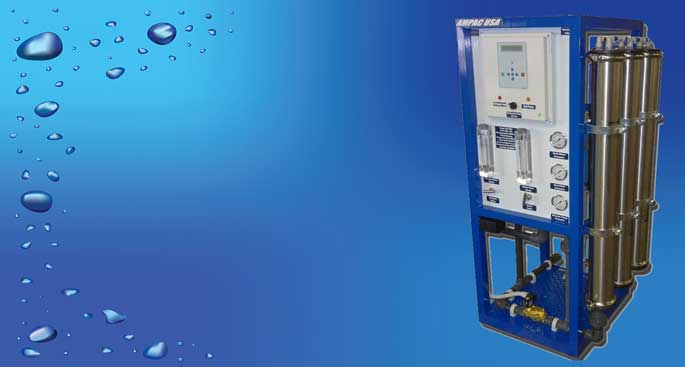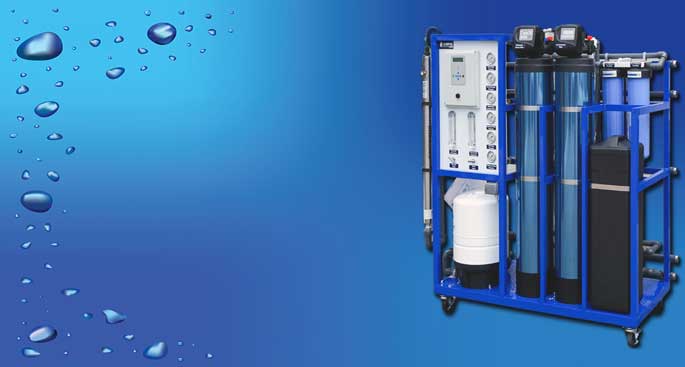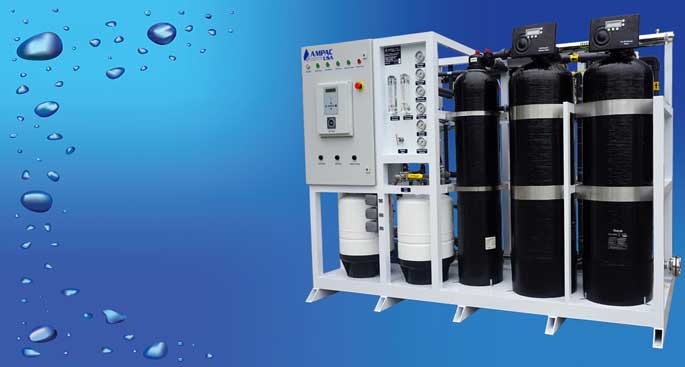Description
What Are Commercial Reverse Osmosis Systems?
Commercial Reverse Osmosis (RO) Systems are advanced water purification units designed to remove dissolved salts, minerals, bacteria, and impurities from water. These systems use high-pressure membranes to deliver clean, safe, and mineral-free water suitable for a wide range of commercial and industrial applications.
AMPAC USA™ commercial reverse osmosis machines are engineered for performance, durability, and efficiency. Whether it's a small café or a large bottling plant, our RO systems deliver consistent results with minimal maintenance. With capacities ranging from 100 GPD to 250,000 GPD, these systems can meet water purification needs of any scale.
All AMPAC USA RO units are constructed with high-grade materials like stainless steel pressure vessels and powder-coated aluminum frames to resist corrosion and wear in challenging environments. They come equipped with features like automatic backwash, pre-filtration, and smart PLC control panels for user-friendly operation.
Explore Our Commercial RO Systems & Machines
AMPAC USA offers a complete range of commercial reverse osmosis systems and commercial RO machines designed to meet the needs of businesses, institutions, and industrial facilities. From light-duty systems to high-capacity units, each solution is engineered for high performance, water purity, and long-term reliability.
| Commercial RO Machine | Capacity (GPD) | Application | Product Link |
|---|---|---|---|
| RO System 100–1,200 GPD | 100 – 1,200 | Restaurants, cafés, dental offices, salons | View Product |
| RO System 1,500–10,000 GPD | 1,500 – 10,000 | Hospitals, hotels, schools, car washes, bottling plants | View Product |
| Brackish Water RO System | Custom | Municipal wells, rural water treatment, saline groundwater | View Product |
| Packaged RO Systems | 1,500 – 100,000+ | Water bottling plants, vending businesses, water stores | View Product |
| Commercial Water Filtration Systems | Various | Pre- and post-treatment solutions for commercial RO machines | View Product |
Commercial Reverse Osmosis Process
Commercial reverse osmosis is a scaled-up version of the traditional RO. It is intended to provide potable water for beverage production, pharmaceuticals, and industrial processes. Through high-pressure pumps and semi-permeable membranes, contaminated water is stripped of dissolved impurities.
The reverse osmosis principle is the opposite of the osmotic process. In osmosis, the molecules of a liquid or solvent pass from a solution of low to high concentration via a semi-permeable membrane. In reverse osmosis, the opposite happens, meaning the pressure is given to that side of the membrane where there is a high concentration of contaminants. Thus, pure water travels from the contaminated to the treated side of the membrane.
Each commercial osmosis system, whether it's a water purification system, packaged reverse osmosis, brackish water reverse osmosis, or commercial water filtration system, is customized based on the quality of water desired and the kinds of raw water issues you have.
Commercial reverse osmosis solutions can have as few as two stages and as many as eight stages. Choosing how many stages you need largely depends on the quality of water that needs to be purified. Usually, 5 stages are enough for a RO system, but you can go higher if you want more purity depending on the use you need to put the purified water too.
What Does a Reverse Osmosis System Consist of?
Though the working of a reverse osmosis system might seem simpler from the above example, it’s a bit more complicated than it seems. A industrial, commercial or residential reverse osmosis system usually has many components. Some of them are explained briefly here:
Pre-treatment
This stage includes the use of carbon filters to ensure the removal of harmful elements like iron, chlorine, manganese, water softeners, sulfur filters, and antiscalant systems.
Reverse osmosis
In this stage, water is passed through a semi-permeable membrane by applying pressure to ensure that the contaminants are trapped and removed. The result is clean and 100% contamination-free water that is tasteless, colorless, and odorless.
Post-treatment
This stage usually includes using ultraviolent disinfection, abbreviated as UV or ozonation, to ensure pH level adjustment, add some hardness to the water, and kill bacteria. It also includes deionization to demineralize the water.
Often, the customers demand to monitor the end of water quality. To accommodate that request, various analyzers can be used.
Storage and distribution
RO systems need a lot of time to purify water up to the desired standards. So, they need tanks to store water. There are usually two types of tanks: atmospheric tanks, which can be anywhere from 75 gallons to 2,000 gallons, and bladder types, which are 14 to 80 gallons. The water quality is higher in atmospheric tanks as compared to bladder type tanks. Atmospheric tanks are usually bigger and have to bladder to supply back pressure. Hence, a booster pump is often needed to re-pressure the water and distribute it at a good pace.
How to Select the Right Commercial RO System?
Selecting the appropriate commercial reverse osmosis system is crucial for businesses that depend on high-quality water for their operations. A well-chosen system ensures efficiency, reliability, and cost-effectiveness. This guide outlines the key factors to consider when choosing a commercial RO system.
Determine water demand and quality
Calculate your daily water usage to ensure the system can meet your needs. Consider peak usage times and future expansion plans. When selecting a system with the appropriate capacity to prevent shortages and ensure consistent performance. Also, determine water quality by knowing things like the hardness of water, tds, chlorine, iron, manganese level, silica, and turbidity.
Evaluate system types
Commercial RO systems come in various configurations. Choose one that is in line with your operational needs and space constraints.
- Standard systems: suitable for general water purification needs.
- High-pressure systems: designed for applications requiring high-pressure water, such as certain industrial processes.
- Large capacity systems: ideal for establishments with high water demand, like hotels or hospitals.
- Customized systems: tailored to meet specific requirements of a business.
Consider energy efficiency
Energy consumption impacts operational costs. The recommended energy consumption for current commercial RO treatment facilities typically ranges from 20 to 45 kwh/(pe- a) (per person equivalent per year). Opt for systems that prioritize energy efficiency with energy recovery devices and high-efficiency pumps to minimize expenses.
Assess maintenance needs
Regular maintenance ensures longevity and optimal performance. Select systems with accessible components and clear maintenance protocols. Additionally, consider the availability of technical support and warranty services from the manufacturer. Ensure regulatory compliance
Ensure that the ro system adheres to local, state, and federal regulations concerning water treatment and waste disposal. Compliance is not only ethically right but also guards against legal complications and possible penalties.
Budget considerations
While it's essential to invest in a quality system, align your choice with your budget without compromising on critical features. Perform a cost-benefit analysis considering not just the initial investment but also operational and maintenance costs to ensure a judicious expenditure.
Space and installation constraints
Evaluate the available space for system installation. Some systems are designed for compact spaces, while others require more room. Ensure the chosen system fits within your spatial constraints and consider future scalability.
Environmental impact
Consider systems that minimize water waste and support sustainability initiatives. Some RO systems are designed to be more water-efficient, reducing the environmental footprint of your operations.
Key Specifications of Our Commercial Reverse Osmosis Systems

Reverse Osmosis commercial applications
Different types of commercial reverse osmosis systems have varying applications.
Food and beverage
commercial reverse osmosis systems, along with other processes like distillation, are typically used for bottled water. Highly advanced commercial water filters extract fresh water for fruit juices and beverages and for the beer brewing process. It is also used for vegetable processing, milk production, and preparation of different kinds of food production. A two-stage reverse osmosis process creates pure water after rectifying the ph value and then uses a high-pressure pump to obtain pure water in these commercial processes.
Pharmaceuticals
Commercial reverse ro systems remove around 99% of contaminants from water. They remove ions and minerals from water through deionization. So, water remains free of contaminants that can disturb reactions and measurements. Deionized water is extremely beneficial for researchers as they can perform various experiments without any threat of inaccurate results that arise from ions in water.
Agriculture
Reverse osmosis systems are for cultivation houses for the plants in greenhouses or aquaculture growing. The solutions remove iron, manganese, hydrogen sulfide, sediments, and sulfur odors. They have immense importance in applications like irrigation, agriculture, hydroponics, greenhouses, and livestock drinking water.
Power Generation
Industrial boilers should not have lime-scale or any other build-up because of their high sensitivity to them. Commercial water filters treat and soften water to eliminate issues like scaling and thermal transfer deficiencies. This safeguards the boilers from premature damage and prevents money from expensive repairs. The quality and efficiency of the boiler stay intact.
Manufacturing
Salt-free water is essential for rinsing applications in manufacturing processes. A reverse RO system effectively removes contaminants like herbicides, nitrates, sugars, antibiotics, and more, which softens water. When hard water reacts with soaps, it leaves residues that demand intense cleaning. Reverse osmosis removes microscopic impurities and treats water effectively.
Why Trust AMPAC USA for Every Commercial Reverse Osmosis Needs?
Extensive Range
When it comes to providing commercial reverse osmosis systems, we have an extensive range that we keep on expanding. No matter whether you need a small RO system for a small commercial establishment like a café or you need a large system for the needs of an expansive resort, you can trust us with both. We create systems that range from 100 gallons per day to 12,000 gallons per day. We have designed systems with a capacity of 250,000 gallons per day as well. In addition to fulfilling commercial water needs, we also design systems for huge industries and military needs.
Serving Every Need
Our RO systems have been deployed in various industries. We create solutions for restaurants, breweries, coffee shops, wineries, seafood processing, boilers, dairy product manufacturers, humidifiers, metal preparation, and even to meet the washing needs of automotive and aerospace industries and dialysis systems.
Long-Lasting Solutions
Loyal clients from around the world trust our RO systems to work efficiently and effectively. These systems are reliable and can offer consistent performance for many years.
Strong Build
Every commercial reverse osmosis system we design would have a smart technical design, unparalleled system architecture, and amazing build quality. We use Powder-coated welded aluminum for all frames, industrial-grade stainless steel is used for pressure vessels, and fastening hardware is used to offer structural strength and corrosion resistance.
User-Friendly Designs
We design, deploy, and deliver easy-to-use systems with simple operations and minimal user intervention. Their maintenance needs are low, and if those few needs are appropriately met, they will last longer than expected.
Different Categories
We have categorized our commercial RO systems into different categories. The first category is for small and mid-sized businesses, as the systems produce just 100-1200 gallons per day. The second category is reverse osmosis systems that produce 1,500-10,000 gallons per day. The next few categories are Brackish Water Reverse Osmosis, Packaged Reverse Osmosis, and Commercial Water Filters.
Applications
Applications of Our Commercial RO Systems
| Application | Description & Benefits |
|---|---|
| Restaurants & Cafés | Ensures clean, great-tasting water for cooking and beverages; improves appliance lifespan. |
| Hospitals & Healthcare Facilities | Delivers purified water for sterilization, lab use, and dialysis-grade applications. |
| Bottling & Beverage Plants | Provides consistent water quality for bottling lines and beverage manufacturing. |
| Agriculture & Hydroponics | Eliminates harmful salts and chemicals; promotes healthier crop yields. |
| Metal Finishing & Car Wash | Prevents spotting and corrosion; supports quality surface preparation and rinsing. |
| Breweries & Wineries | Improves water quality for fermentation, brewing, and rinsing equipment. |
| Schools, Hotels & Institutions | Ensures safe and reliable drinking water for staff, guests, and students. |
Features and Benefits
Benefits of Our Commercial Reverse Osmosis Systems
| Feature | Benefit |
|---|---|
| Fully Assembled & Tested | Delivered ready to operate with minimal user setup—connect water lines and go. |
| Space-Efficient Design | Compact commercial RO systems for wall-mount, floor, or table-top installation. |
| Wide Range of Capacities | 100 GPD to 10,000 GPD and beyond to meet small to large-scale water needs. |
| Comprehensive Filtration | Includes feed pump, pre-treatment, RO membranes, and post-treatment with UV. |
| Smart Automation | UL/CE approved PLC controller with TDS monitor, auto flush, tank level control, and hour meter. |
| Premium Quality Construction | Made in the USA using powder-coated aluminum and stainless steel to ensure NSF/WQA/ISO 9001 quality standards. |
Compare RO Systems: Commercial vs. Industrial vs. Residential
Choosing the right reverse osmosis system depends on your specific water purification needs. Below is a detailed comparison between commercial RO machines, industrial reverse osmosis systems, and residential RO systems to help you make an informed decision. Whether you’re running a small business, a large facility, or need clean water for home use, this guide will clarify which system fits best.
| Feature | Commercial RO Systems | Industrial RO Systems | Residential RO Systems |
|---|---|---|---|
| Typical Capacity | 100 – 10,000 GPD | 10,000 – 250,000 GPD | 50 – 100 GPD |
| Applications | Restaurants, hospitals, bottling, agriculture | Manufacturing, municipal water, pharma | Household drinking water |
| Water Quality Treated | Tap, brackish, low TDS well water | Brackish, seawater, high TDS water | Tap water |
| System Size | Compact to mid-sized | Large-scale, skid-mounted units | Under-sink units |
| Maintenance | Moderate (pre-filters, membrane care) | Advanced (industrial-level upkeep) | Minimal (cartridge replacement) |
| Cost Range | $2,000 – $20,000+ | $20,000 – $100,000+ | $150 – $600 |
Top 10 Frequently Asked Questions about Commercial RO Machines
1. What recovery rate can I expect from a commercial RO machine?
Commercial RO systems typically achieve a 50% to 85% recovery rate, meaning that 50 to 85 gallons of purified water are produced for every 100 gallons of feed water.
2. What maintenance do commercial RO systems require?
Routine maintenance includes quarterly membrane cleaning, replacing pre-filters every 6–12 months, and sanitizing the system every 6 months to ensure consistent performance.
3. Why does my RO machine have low flow or pressure?
Low flow may result from clogged pre-filters, fouled membranes, low feed pressure, cold inlet water, or a faulty high-pressure pump.
4. How much wastewater is produced by these systems?
Commercial RO systems usually reject 15% to 50% of the feed water depending on recovery rate. Some systems offer reject water reuse or brine minimization features.
5. How high should the operating pressure be?
For brackish and freshwater applications, 40–80 psi is typical. Seawater RO systems require significantly higher pressures, ranging from 600 to 1,200 psi.
6. What contaminants does commercial RO remove?
These systems effectively remove salts, heavy metals (lead, arsenic), bacteria, viruses, pesticides, nitrates, and dissolved solids (TDS).
7. What causes membrane scaling?
Membrane scaling is caused by calcium, magnesium, and sulfate ions present in hard water. Pre-treatment and antiscalant dosing help prevent this issue.
8. What is the lifespan of an RO membrane?
RO membranes in commercial systems typically last 2–5 years depending on feed water quality, maintenance frequency, and operating conditions.
9. Do commercial RO systems need electricity?
Yes, they require electricity to power the high-pressure pump and automated control systems (PLC, TDS meter, UV disinfection, etc.).
10. Is water testing required before installation?
Yes, a professional water analysis is essential to determine TDS levels, hardness, pH, and contaminant profile. This ensures proper system selection and pre-treatment setup.






